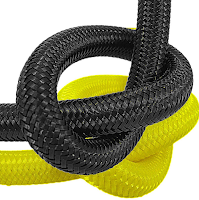 |
| 📸 (c) User Szdavid |
Almost every new regulator we buy comes with plastic hose protectors. On the other hand, expecially among tech divers, we often see “naked” configurations without any sort of protection on the hoses.
Plastic protectors have basically one simple purpose: to protect the hoses from exagerated bending and crimping in one of the weakest positions of the construction, next to the joints where the metal plugs meet the rubber.
Nevertheless nowadays flex hoses are becoming a more and more popular standard: this particular kind of polymer or carbon braided hose offers greater resistance to bending, preventing the hose from crimping and thus making hose protectors useless.
In any case, whether you use rubber or braided hoses, I would discourage the use of plastic protectors for the following reasons:
Plastic protectors have basically one simple purpose: to protect the hoses from exagerated bending and crimping in one of the weakest positions of the construction, next to the joints where the metal plugs meet the rubber.
Nevertheless nowadays flex hoses are becoming a more and more popular standard: this particular kind of polymer or carbon braided hose offers greater resistance to bending, preventing the hose from crimping and thus making hose protectors useless.
In any case, whether you use rubber or braided hoses, I would discourage the use of plastic protectors for the following reasons:
- As said above, plastic protectors shield the weakest part of the system, which is also the most likely to fail. If we remove the protectors it will be easier to spot any possible small gas leak coming from a damaged o-ring, oxidized thread or swivel. In fact, hose protectors could partially dam small leaks, making a potentially serious problem invisible during the bubble check in shallow water.
- Hose protectors are the perfect place for salt, dirt and sand to collect, accelerating the oxidation process of metal parts of the hose. This is why every time we rinse our regulator we shall remove the protectors, which leads to no. 3 & 4.
- Some protectors are very tight: every time we remove them for rinsing properly our gear we put a lot of mechanical stress on the metal joints and threads of our regulator, increasing the risk of damage and accelerating the wear process. In addition, some protectors are made out of very hard material and from time to time I have seen hoses bending and crimping at the free end of these protectors!
- On the contrary, loose protectors tend to slip down along the hose by themselves, thus not serving their purpose and being completely useless.
So now you might ask yourself: how do I prevent my rubber hoses from bending next to the joints?
Simple, look after your equipment! This is all about pretty expensive gear that provides us life support, basically we are speaking about the most important piece of equipment, so take care of your kit, do not drag the hoses when moving the assembled gear, rinse it properly after use, and pack the regulator properly when traveling!




No comments:
Post a Comment